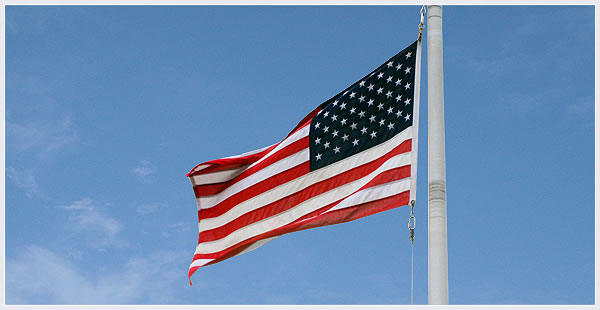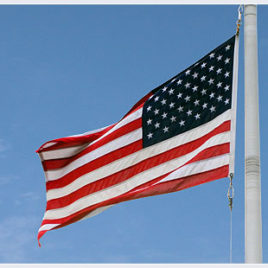Description
Poly-Max U.S. Outdoor Flag (Embroidered Stars and Sewn Stripes)
(Appliquéd stars on 10’ x 15’ and larger)
Recognized as the most durable of all flag fabrics Poly-Max U.S. Flags are skillfully crafted of 2-ply 1–% polyester bunting. Its open weave construction reduces wind resistance, therefore lessening abrasion and increasing flag life. Resists wear to wind, dirt and moisture and is ideal for industrial and institutional applications. Designed specifically for the needs of the most discriminating customer, this flag will prove to be the most durable, longest lasting flag available.
…
 Embroidered Stars
Embroidered Stars
Beautifully embroidered snow-white stars are standard on all flags (except Sun-Brite Flags) through 8′ x 12′.
…
 Appliqued Stars
Appliqued Stars
Flags larger than 8′ x 12′ have opaque nylon white stars with zig-zag stitching throughout.
…
 Stitching
Stitching
All seams are double-stitched and fly ends have either 2, 4 or 6 rows of double-stitching for added durability.
…
 Headers
Headers
All flags are finished with heavy-duty no-shrink white header material for the strongest headers in the industry.
…
 Brass Grommets
Brass Grommets
Flags through size 6′ x 10′ feature strong, durable solid brass grommets.
…
 Metal Thimbles
Metal Thimbles
Flags 8′ x 12′ and larger are finished with super-strong nylon rope sewn into the header with galvanized metal thimbles.
…
THERE IS A DIFFERENCE
The spun polyester material that we use of our Poly-Max U.S. Outdoor Flags is produced with a Jet Dying process. Our Jet Dying process forces the dye molecules into the fabric at 265 F. Polyester materials which are dyed with a beam process cannot attain temperatures over 210 F thus producing a ring dyeing effect. The dye molecules are forced into the substrate and subsequently dye only the outermost parts of the fiber. If you are looking for a flag that exhibits superior wetfastness, lightfastness and a more luxurious hand, then our Jet dyed Poly-Max Flags are your only choice.
How Long Should a Flag Last?
There is no definite answer to this question. How long any flag will last depends on the weather, it’s location, airborne contamination and how often you fly your flag. Remember, your flag is a piece of cloth that works very, very hard. Throughout its lifetime your flag shakes, trembles, drapes, snaps, chafes, bakes, freezes, ripples, flutters, furls, twists, flaps, strains, flies, unfurls and hangs! Is it any wonder that a flag that flies continuously needs replacing two or times year? Wind, water, sun and carelessness are the major enemies of a flag. No one can control the weather but you can take some important steps to lengthen the life of your flag. Occasionally washing your flag in warm detergent water will prevent pollutants and dirt from weakening the fabric. Always let your flag dry thoroughly before storing it to prevent mildew or color transfer. At the first sign of fraying, have your flag repaired before further damage is done. Always keep your flagpole as clean as possible and move your pole if your flag does not have adequate room to fly unobstructed.


